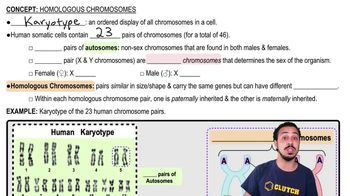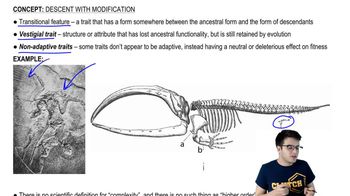Table of contents
- 1. Introduction to Biology2h 42m
- 2. Chemistry3h 40m
- 3. Water1h 26m
- 4. Biomolecules2h 23m
- 5. Cell Components2h 26m
- 6. The Membrane2h 31m
- 7. Energy and Metabolism2h 0m
- 8. Respiration2h 40m
- 9. Photosynthesis2h 49m
- 10. Cell Signaling59m
- 11. Cell Division2h 47m
- 12. Meiosis2h 0m
- 13. Mendelian Genetics4h 44m
- Introduction to Mendel's Experiments7m
- Genotype vs. Phenotype17m
- Punnett Squares13m
- Mendel's Experiments26m
- Mendel's Laws18m
- Monohybrid Crosses19m
- Test Crosses14m
- Dihybrid Crosses20m
- Punnett Square Probability26m
- Incomplete Dominance vs. Codominance20m
- Epistasis7m
- Non-Mendelian Genetics12m
- Pedigrees6m
- Autosomal Inheritance21m
- Sex-Linked Inheritance43m
- X-Inactivation9m
- 14. DNA Synthesis2h 27m
- 15. Gene Expression3h 20m
- 16. Regulation of Expression3h 31m
- Introduction to Regulation of Gene Expression13m
- Prokaryotic Gene Regulation via Operons27m
- The Lac Operon21m
- Glucose's Impact on Lac Operon25m
- The Trp Operon20m
- Review of the Lac Operon & Trp Operon11m
- Introduction to Eukaryotic Gene Regulation9m
- Eukaryotic Chromatin Modifications16m
- Eukaryotic Transcriptional Control22m
- Eukaryotic Post-Transcriptional Regulation28m
- Eukaryotic Post-Translational Regulation13m
- 17. Viruses37m
- 18. Biotechnology2h 58m
- 19. Genomics17m
- 20. Development1h 5m
- 21. Evolution3h 1m
- 22. Evolution of Populations3h 52m
- 23. Speciation1h 37m
- 24. History of Life on Earth2h 6m
- 25. Phylogeny2h 31m
- 26. Prokaryotes4h 59m
- 27. Protists1h 12m
- 28. Plants1h 22m
- 29. Fungi36m
- 30. Overview of Animals34m
- 31. Invertebrates1h 2m
- 32. Vertebrates50m
- 33. Plant Anatomy1h 3m
- 34. Vascular Plant Transport1h 2m
- 35. Soil37m
- 36. Plant Reproduction47m
- 37. Plant Sensation and Response1h 9m
- 38. Animal Form and Function1h 19m
- 39. Digestive System1h 10m
- 40. Circulatory System1h 57m
- 41. Immune System1h 12m
- 42. Osmoregulation and Excretion50m
- 43. Endocrine System1h 4m
- 44. Animal Reproduction1h 2m
- 45. Nervous System1h 55m
- 46. Sensory Systems46m
- 47. Muscle Systems23m
- 48. Ecology3h 11m
- Introduction to Ecology20m
- Biogeography14m
- Earth's Climate Patterns50m
- Introduction to Terrestrial Biomes10m
- Terrestrial Biomes: Near Equator13m
- Terrestrial Biomes: Temperate Regions10m
- Terrestrial Biomes: Northern Regions15m
- Introduction to Aquatic Biomes27m
- Freshwater Aquatic Biomes14m
- Marine Aquatic Biomes13m
- 49. Animal Behavior28m
- 50. Population Ecology3h 41m
- Introduction to Population Ecology28m
- Population Sampling Methods23m
- Life History12m
- Population Demography17m
- Factors Limiting Population Growth14m
- Introduction to Population Growth Models22m
- Linear Population Growth6m
- Exponential Population Growth29m
- Logistic Population Growth32m
- r/K Selection10m
- The Human Population22m
- 51. Community Ecology2h 46m
- Introduction to Community Ecology2m
- Introduction to Community Interactions9m
- Community Interactions: Competition (-/-)38m
- Community Interactions: Exploitation (+/-)23m
- Community Interactions: Mutualism (+/+) & Commensalism (+/0)9m
- Community Structure35m
- Community Dynamics26m
- Geographic Impact on Communities21m
- 52. Ecosystems2h 36m
- 53. Conservation Biology24m
21. Evolution
Introduction to Evolution and Natural Selection
Problem 4`
Textbook Question
The upper forelimbs of humans and bats have fairly similar skeletal structures, whereas the corresponding bones in whales have very different shapes and proportions. However, genetic data suggest that all three kinds of organisms diverged from a common ancestor at about the same time. Which of the following is the most likely explanation for these data?
a. Forelimb evolution was adaptive in people and bats, but not in whales.
b. Natural selection in an aquatic environment resulted in significant changes to whale forelimb anatomy.
c. Genes mutate faster in whales than in humans or bats.
d. Whales are not properly classified as mammals.
 Verified step by step guidance
Verified step by step guidance1
Identify the key concept: The problem is about evolutionary biology, specifically the concept of homologous structures and how they can evolve differently in different environments.
Understand homologous structures: Homologous structures are anatomical features in different species that originated from a common ancestor. They may have different functions but share a similar underlying structure.
Analyze the environmental influence: Consider how different environments can lead to different evolutionary pressures. In this case, whales live in an aquatic environment, which could lead to significant adaptations in their forelimb structure compared to terrestrial environments.
Evaluate the options: Option b suggests that natural selection in an aquatic environment led to changes in whale forelimb anatomy. This aligns with the concept of adaptive evolution, where organisms evolve traits that are advantageous in their specific environments.
Conclude with the most likely explanation: Based on the understanding of homologous structures and environmental adaptation, option b is the most plausible explanation for the observed differences in forelimb anatomy among humans, bats, and whales.
 Verified video answer for a similar problem:
Verified video answer for a similar problem:This video solution was recommended by our tutors as helpful for the problem above
Video duration:
1mPlay a video:
Was this helpful?
Key Concepts
Here are the essential concepts you must grasp in order to answer the question correctly.
Homologous Structures
Homologous structures are anatomical features in different species that originated from a common ancestor, reflecting evolutionary relationships. Despite differences in function, such as human arms and bat wings, these structures share a similar skeletal framework, indicating a shared evolutionary lineage. This concept helps explain why organisms like humans, bats, and whales have similar forelimb structures despite their diverse adaptations.
Recommended video:
Guided course

Homologous Chromosomes
Natural Selection
Natural selection is the process by which organisms better adapted to their environment tend to survive and reproduce, leading to evolutionary changes over time. In the context of whales, natural selection in an aquatic environment could drive significant anatomical changes in their forelimbs, optimizing them for swimming. This concept is crucial for understanding how environmental pressures can lead to divergent evolutionary paths in species with a common ancestor.
Recommended video:

Natural Selection
Adaptive Evolution
Adaptive evolution refers to changes in organisms that enhance their survival and reproduction in specific environments. It involves the modification of traits through natural selection, resulting in adaptations like the streamlined forelimbs of whales for aquatic life. This concept explains why certain species, such as whales, exhibit significant anatomical differences from their terrestrial relatives, despite sharing a common ancestor.
Recommended video:

Adaptive Radiation

 4:58m
4:58mWatch next
Master Evolution and Natural Selection with a bite sized video explanation from Jason
Start learningRelated Videos
Related Practice
































